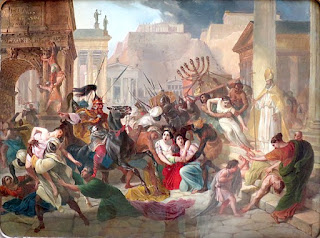From that point Prosper appears in no records until 440, when he is a secretary in the papacy of Leo I. He never took orders, but he was thoroughly involved in religious institutions. He wrote De vocatione omnium gentium ("The Call of all Nations"), in which he urges all Gentiles to embrace Augustine's idea of God's Grace. He wrote a 1000-line poem in which he attacked Pelagianism.
Prosper left us the Epitoma Chronicon ("Ultimate History"), a continuation of a history by St. Jerome, in which he covers the Belgian controversy and world history. He first composed it in 443, but released several subsequent editions with updates. The final edition was in 455 and covers the death of Valentinian III, which is traditionally given as the year of Prosper's death. (The historian Marcellinus Comes mentions Prosper in the year 463, but Marcellinus was in Constantinople and was not an eyewitness to events in the Western Empire.)
It is Prosper who tells us that, when the Vandals approached Rome to sack it in 455, Pope Leo the Great met with their leader, Genseric, to request that he refrain from burning and killing, but content himself with pillaging.
Prosper's other focus, besides Pelagianism, was the shameful behavior of certain Roman generals, such as Magnus Maximus:
Maximus was made emperor in Britain in an uprising of the soldiery. He soon crossed to Gaul. Gratian was defeated at Paris owing to the treason of Merobaudes the magister militium, and was captured in flight at Lyon and killed. Maximus made his son Victor his colleague in power.
The tyrant Maximus, despoiled of his royal garments by the emperors Valentinian and Theodosius at the third milestone from Aquileia, was called forth to judgement and condemned to death. In the same year his son Victor was killed by Comes Arbogast in Gaul.
Prosper is also our chief source for the details of the Vandal invasion in Europe and North Africa. He blames the general Castinus for losing against the Vandals in Spain, allowing them to conquer the province of North Africa and leading to the death of St. Augustine. (Of course, Augustine was 75 at the time of his death, so it is not quite fair to blame the Vandals.)
Among other writings of his were the Sententia ("Sentences"), 392 maxims supporting the writings of Augustine, and Epigrammata ("Epigrams"), 106 short verses drawn from other sources. The Epigrammata exist in 180 manuscripts from the Middle Ages.
But why did Prosper have to go to Rome to speak to the pope about Augustine? Wasn't Augustine one of the respected fathers of the Church? Let's look at Celestine tomorrow and see why that might have been.




